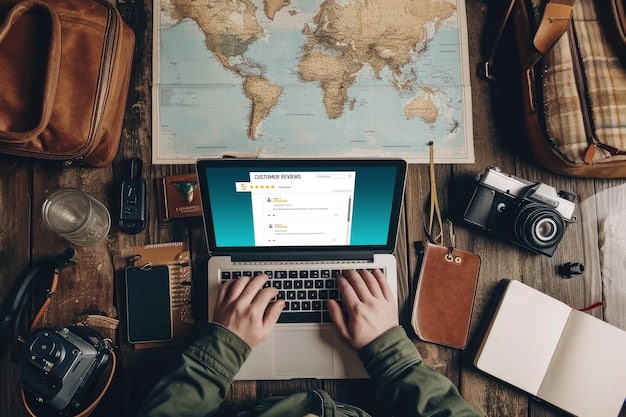US State Department’s Spring Break 2025 Travel Advisories: Your Safety Guide

US State Department Issues New Travel Advisories for Spring Break 2025, encompassing destinations worldwide, necessitating travelers to stay updated on potential risks, health precautions, and security measures to ensure a safe and informed travel experience during the popular vacation period.
Planning your Spring Break 2025 getaway? Before you pack your bags and head for sun and fun, it’s crucial to be aware of the US State Department Issues New Travel Advisories for Spring Break 2025: Stay Informed and Safe. These advisories provide essential information to help you make informed decisions and stay safe during your travels.
Understanding the US State Department’s Travel Advisory System
The US State Department plays a critical role in keeping American citizens safe abroad. One of the key ways they do this is through their travel advisory system. This system provides different levels of advice, ranging from general precautions to outright warnings against travel.
Understanding how the system works, what the different advisory levels mean, and how to use this information will help you make smart decisions about your Spring Break 2025 travels.
Levels of Travel Advisories
The State Department uses a color-coded system, each level representing a different degree of risk. Take note of these levels when planning your trip.
- Level 1 (Blue/Green): Exercise Normal Precautions. This is the lowest advisory level, suggesting travelers should be aware of general safety and security risks.
- Level 2 (Yellow): Exercise Increased Caution. There are heightened risks in specific areas or situations. Be aware of your surroundings and avoid potential dangers.
- Level 3 (Orange): Reconsider Travel. The State Department advises against non-essential travel due to serious risks to safety and security.
- Level 4 (Red): Do Not Travel. This is the highest advisory level, indicating life-threatening risks. US citizens are strongly advised not to travel to these destinations.
Remember to check the specific details for each country and region you plan to visit, as the advisory levels can vary greatly.
In conclusion, understanding these travel advisory levels is crucial for planning a safe Spring Break 2025. Always stay informed and prioritize your safety.
Key Regions and Countries Under Scrutiny for Spring Break 2025
Certain regions and countries traditionally popular for Spring Break often come under the US State Department’s scrutiny due to various factors. Understanding which destinations might have elevated travel advisories can help you adjust your plans accordingly.
Let’s explore some key regions and factors that contribute to these advisories, so you can make informed choices.
Mexico and the Caribbean
Mexico and the Caribbean are perennial favorites for Spring Breakers. However, some areas may have higher advisory levels due to crime, health concerns, or other risks. Always check the specific advisory for your destination.
Europe
While generally considered safe, events may lead to localized advisories in European destinations. Stay updated on any specific warnings or alerts for your travel dates.
Other International Destinations
Destinations in Asia, South America, and Africa may have varying advisory levels depending on local conditions. Research the specific risks associated with each location before making your plans.

Keeping an eye on evolving advisories for these key regions enables travelers to select safe locations for their Spring Break. Staying informed is the ultimate key to enjoying a relaxed break.
Health and Safety Precautions Recommended by the State Department
Beyond general safety and security, the US State Department also emphasizes health precautions. Being proactive about your health can prevent unexpected problems during your trip. These precautions range from vaccinations to basic hygiene practices.
Here’s a breakdown of the health-related advice you should consider before heading out for Spring Break 2025.
Vaccinations and Medical Checkups
Ensure you are up-to-date on all necessary vaccinations for your destination. Schedule a checkup with your doctor to discuss any potential health risks and obtain necessary prescriptions.
Travel Insurance
Comprehensive travel insurance is a must. It should cover medical emergencies, trip cancellations, and lost or stolen belongings. Review the policy details carefully to understand what is covered.
Basic Hygiene and Health Practices
Practice good hygiene to avoid common travel illnesses. Wash your hands frequently, drink bottled water, and be cautious about the food you consume. Carry hand sanitizer and any personal medications you may need.
- Stay hydrated
- Use sunscreen
- Avoid risky activities that can lead to injury
Taking these health and safety measures is a great way to ensure a healthy Spring Break vacation.
In summary, by prioritizing your health and taking preventive measures, you can protect yourself from common travel-related health problems and fully enjoy your Spring Break 2025.
Navigating Potential Risks: Crime, Terrorism, and Natural Disasters
The world is full of uncertain situations. Certain destinations may carry varying levels of risk related to crime, terrorism, or natural disasters. Staying informed and preparing for these risks is essential for a safe trip.
Here’s how to navigate these potential risks effectively.
Understanding Local Crime Rates
Research the crime rates in the areas you plan to visit. Be aware of common scams and petty theft. Avoid walking alone at night in unfamiliar areas and secure your belongings.
Staying Alert to Terrorism Threats
Stay informed about potential terrorism threats in your destination. Follow local news and heed warnings from authorities. Be vigilant in public places and report any suspicious activity.
Preparing for Natural Disasters
Check the risk of natural disasters such as hurricanes, earthquakes, or floods in your destination. Know the evacuation routes and emergency procedures. Pack a basic emergency kit with essentials like water, food, and a first-aid kit.
In short, being aware and prepared can help you greatly when an unexpected situation arises.
Ultimately, being well-informed helps you stay safe through Spring Break and lets you focus on the great memories you will create.
Utilizing State Department Resources: STEP Program and Embassy Assistance
The US State Department provides valuable resources to assist citizens traveling abroad. One of the most important is the Smart Traveler Enrollment Program (STEP). Using these services can provide you with added security and peace of mind.
Here’s how to make the most of these resources during Spring Break 2025.
Enrolling in the Smart Traveler Enrollment Program (STEP)
STEP is a free service that allows US citizens to register their trip with the State Department. This enables the embassy to contact you in case of an emergency, such as a natural disaster or civil unrest. It also ensures you receive important safety updates and alerts.
Contacting the US Embassy or Consulate
Know the location and contact information for the US embassy or consulate in your destination. They can provide assistance if you encounter legal, medical, or other emergencies. Keep their contact details easily accessible.
Following State Department Alerts and Updates
Stay informed by monitoring the State Department’s website and social media channels for the latest travel alerts and updates. These resources provide real-time information about potential risks and safety recommendations.

All in all, these tools can aid in providing you with a secure trip. Stay in contact with the Department when you travel.
In final analysis, utilizing the State Department’s resources enhances your safety and provides crucial support during international travel. Enrolling in STEP and staying informed ensures you are prepared for any unexpected situation.
Making Informed Decisions: Balancing Fun and Safety During Spring Break
Spring Break is a time for fun and relaxation, but it’s essential to balance enjoyment with safety. By making informed decisions and staying vigilant, you can have a great time while minimizing potential risks. Use the advice provided by the State Department to have the best experience.
Here are key takeaways for making smart choices during Spring Break 2025.
Respecting Local Laws and Customs
Familiarize yourself with the local laws and customs of your destination. Avoid engaging in illegal activities and be respectful of cultural norms. This can help you avoid legal trouble and maintain positive relationships with locals.
Avoiding Risky Behaviors
Be mindful of the risks associated with excessive alcohol consumption, drug use, and reckless behavior. These activities can impair your judgment and make you more vulnerable to accidents and crime. Practice moderation and stay aware of your surroundings.
Staying Connected and Informed
Keep in touch with friends and family back home and share your itinerary with them. Stay informed about local events and potential safety concerns. By staying connected and informed, you can quickly respond to any unexpected situations.
In summary, remember to have fun but also to think about your safety constantly.
By respecting local cultures, taking care with risky behavior, and staying connected, you can balance adventure and safety, maximizing your Spring Break experience.
| Key Point | Brief Description |
|---|---|
| ⚠️ Travel Advisories | Check the US State Department’s travel advisories before you go. |
| 🩺 Health Precautions | Get necessary vaccinations and consider travel insurance. |
| 🚨 Local Laws | Respect local laws and customs; avoid risky behaviors. |
| 📧 STEP Program | Enroll in STEP for emergency updates and contact. |
What are the main concerns highlighted in the new travel advisories?
Why is enrolling in STEP important for Spring Break travelers?
What health precautions should I take before my trip?
How can I stay informed about safety risks during Spring Break?
What should I do in case of an emergency while abroad?
The **US State Department Issues New Travel Advisories for Spring Break 2025: Stay Informed and Safe** to prepare people to respect the location that they are visiting.





